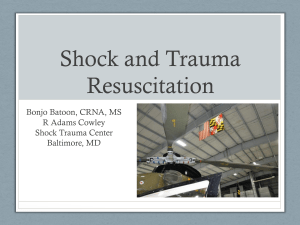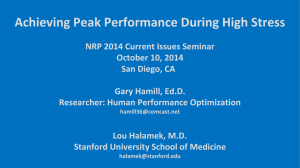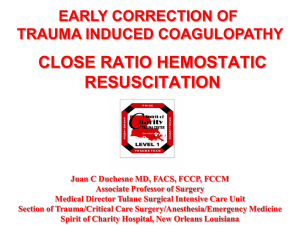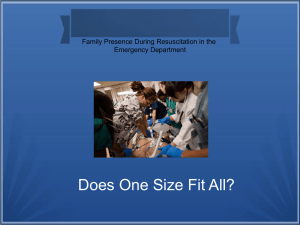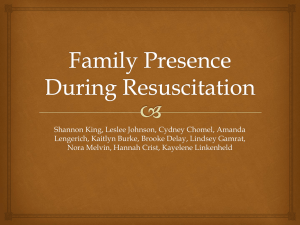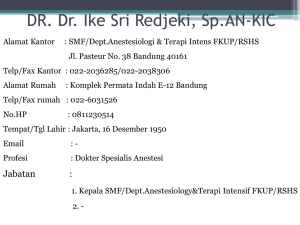Resuscitation of the Surgical Patient
advertisement
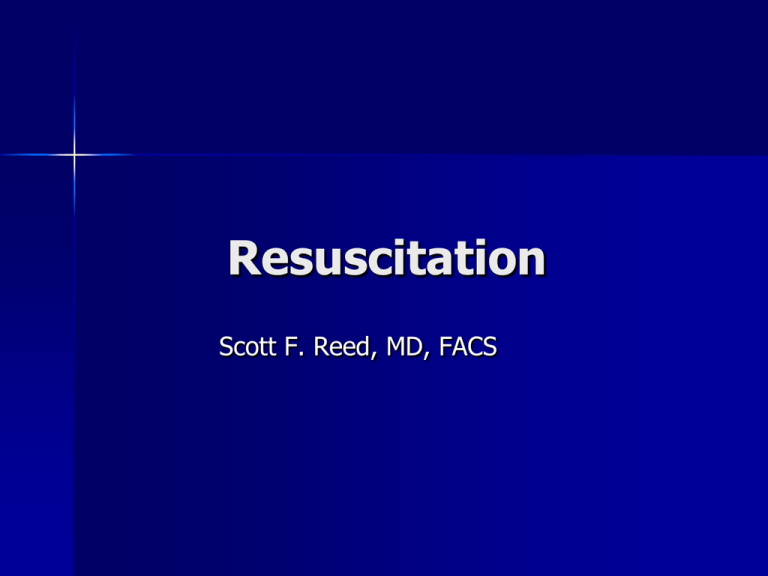
Resuscitation Scott F. Reed, MD, FACS Resuscitation Blood – Greeks – One of the 4 essential humors – Contained your “vital essence.” Always a point of confusion – Mental illness (bad humor) – take the blood out – Swelling / inflammation – blood letting Resuscitation 1628 – William Harvey – Described the anatomy of the circulatory system (closed system) – Maybe we should try to keep the blood in the system Resuscitation 1665 – Richard Lower – transfused blood between two animals 1667 – Jean-Baptist Denis – transfused lambs blood into a patient with mental illness 1668 – British Royal Society – banned transfusions 1669 – France and the Vatican followed And that was the end of that… Resuscitation 1818 – James Blundell – Successful human-to-human transfusion 1901 Karl Landsteiner (Vienna) discovered the ABO system 1915 Lewinsohn (Mt. Sinai hosp, NY) added citrate and glucose (could now store blood for about 2 weeks) Resuscitation 1832 Thomas Latta (Scottish) and William Brook O’Shaughnessy (Irish) – Working on Cholera – Saline solutions to restore the specific gravity of the blood History 1883 – Sidney Ringer – found that frog hearts perfused with New River Water Co. (City water) lasted longer than those perfused with distilled water – Proposed the calcium was the difference 1934 Hartmann – added sodium lactate and called it lactated Ringer’s solution Resuscitation Walter Cannon – Used 4% saline as war-time resuscitation fluid – 1918 “If the pressure is raised before the surgeon is ready to check any bleeding that may take place, blood that is sorely needed may be lost.” Problem Problem Most of our resuscitation is based on fluids from the last century (in a fancy new bag) Resuscitation What you want – Reversal of shock state (restoration of cellular perfusion) – Maintenance of blood / fluid volume to ensure adequate hemodynamics – Maintenance of coagulation factors – Prevent hypothermia / hypocalcemia – Way to follow your progress (are we making ground or falling behind?) Resuscitation What you DON’T want – Fail to meet metabolic demands – Increase ongoing bleeding – Dilute coagulation factors – Over or under resuscitate the patient Resuscitation Goldilocks theory Too little… – – – – Ongoing shock Continued acidosis Coagulopathy Myocardial dysfunction – Renal failure – Shock liver – Death Too much… – Increased bleeding (disruption of clot) – Dilution of coagulation factors – Compartment syndromes – Transfusion related problems Inflammation / immunosuppression TRALI Disclaimer Wars have been waged over less controversial issues than resuscitation. – There is no perfect fluid – There is no perfect measure / end point – There is enough variability as to make studying the problem very difficult Resuscitation Shock (What type of problem) – Hemorrhagic (trauma, AAA, GI bleed) Tank is leaking and becoming empty Solution: Fix the hole(s) – Sepsis Blood / Fluid level may be OK but the tank is too big. (shunting and mitochondrial dysfunction) Solution: Fix the source of infection Damage Control Resuscitation Resuscitation Concepts to discuss – Hypotensive resuscitation – Small volume resuscitation – Blood product ratios – Autotransfusion – End points of resuscitation Then we can discuss some articles that actually support (and some that refute) the position so you don’t think that I’m making this stuff up. Resuscitation So what about this lecture??? – It is NOT a lecture (lectures are boring and reserved for our children.) – This is an exchange of ideas so please ask questions. – You won’t be a convert to any of this because the data is shaky, and the concepts will change. Hypotensive Resuscitation Idea that the higher the blood pressure, the faster the bleeding Higher pressures will disrupt newly forming clot Not a new idea Hypotensive Resuscitation What is done – Maintain a lower BP until the bleeding is controlled – Then increase rate / volume of resuscitation. Questions – How low is too low? – How long can the lower MAP be maintained? Hypotensive Resuscitation Hypotensive Resuscitation On arrival Acid base standpoint – about the same Hemoglobin / coagulopathy - better to wait NEJM Oct 27, 1994, Vol. 331 No. 17 Hypotensive Resuscitation Before OR 2.6 liters vs 386ml Overall Crystalloid 9,250 6,904 NEJM Oct 27, 1994, Vol. 331 No. 17 Hypotensive Resuscitation NEJM Oct 27, 1994, Vol. 331 No. 17 Hypotensive Resuscitation NEJM Oct 27, 1994, Vol. 331 No. 17 Compared trauma patients that has one SBP<90 who were randomized to resuscitation to SBP 0f 100 vs 70. J. of Trauma – Vol 52, #6 Hypotensive Resuscitation Yeah, but that ATLS book says I have to give 2 liters of LR to every trauma patient who is hypotensive Hypotensive Resuscitation But…It seems that large volumes of crystalloid may be detrimental. – Pulmonary edema – Compartment syndromes – Dilution of coagulation factors Is there a better way? Small Volume Resuscitation Using a hypertonic / hyperosmotic fluid that will remain in the vascular space longer, with less extravasation into the interstitium – thus restoring vascular volume. Hespan / Hetastend Albumin Hypertonic Saline (3% to 7.5%) Small Volume Resuscitation Standard procedure in the military – 7.5% saline / 6% hespan in a 250cc bolus Can’t logistically carry liters of fluid in the field Hespan / Hetastend Large carbohydrate molecule – May cause coagulopathy in large doses (30ml per Kg) in a 70kg person 2.1 liters – Renal tubular dysfunction concern Hetastarch 1,714 pts (805 hetastarch / 909 standard care) 85% of HET got 500cc / 15% got 1000cc No difference in coagulopathy or urine outputs Hetastarch in safe and effective in the doses used JACS May 2010, Vol 210, No. 5 Hetastarch 500cc of hetastarch expands the blood volume 800cc whereas it would take approximately 3 liters of LR to do the same Hypertonic Saline 3% saline Longer intravascular half life and expands blood volume 1:1.5 Better at reducing intra-cranial pressures than mannitol Doesn’t activate neutrophils like LR Albumin No good studies that look specifically at using albumin in a resuscitation setting. – S.A.F.E. trial (getting kind of old – didn’t use very high volumes in any comparison group) – no difference between saline and albumin in ICU patients Small Volume Resuscitation The Cochran Library – 2009 Issue #3 The Moral of the Story The Cochran Library – 2009 Issue #3 Blood Product Ratios Acute Coagulation of Trauma Shock (ACoTS) – Classic “lethal triad” Coagulopathy Acidosis Hypothermia – Loss, dilution and dysfunction Loss – factors are consumed Dilution – transfused with non-factor fluids Dysfunction – protease due to acidosis / cold Frith, D, Brohi,K The Acute Coagulopathy of Trauma Shock – Clinical Relevance. Surgeon, 2010 #8 (159-163) Blood Product Ratios 7 Year retrospective trial – 435 emergency surgeries with over 10 units PRBC’s – 135 with trauma induced coagulopathy (INR > 2, PT> 16, PTT>50sec) and 53 died (39.5%) Journal of Trauma July 2009 Vol 67, No1 Blood Product Ratios Looking at the ratios of PRBC’s to FFP in those with TIC – 1:1 vs 1:4 Mortality 28.2 vs 51.1 – 1:2 vs 1:3 Mortality 38% vs 40% Journal of Trauma July 2009 Vol 67, No1 Blood Product Ratios Problems – Small sample – Did the most severely injured pt’s get blood, then die while the FFP was thawing? – Other studies don’t show the same advantage Blood Product Ratios 32 patients Transcutaneous probe on thenar eminence one hour before and 4 hours after transfusion Two groups (old blood over 21 days and new blood less than 21 days old) Journal of Trauma July 2009 Vol 67, No1 Blood Product Ratios Autotransfusion Perfect resuscitation fluid – Perfect antigen match – Carry oxygen – Low cost Military – “walking blood bank” – personnel are typed beforehand and donate as needed so pt gets fresh whole blood Autotransfusion Typically red cells are separated from plasma, “washed”, then concentrated and given back to the patient as PRBC’s – What does it really cost? – Does it decrease donated PRBC use? – What about contamination? Autotransfusion Using a cell saver 47 control / 47 in cell saver group (avg 819ml of blood) Cell saver group: less intra-op donated blood (2 vs 4 units) less total blood (4 vs 8 units) less plasma (3 vs 5 units) Cost of blood products ($1616 vs $2584) Arch Surg – Vol 145 (No 7) July 2010 Autotransfusion No increase in infectious complications Arch Surg – Vol 145 (No 7) july 2010 Several articles where contaminated blood was used – no increase in infections Timberlake, GA, McSwain, NE Autotransfusion of blood contaminated by enteric contents: a potentially life-saving measure in the massively hemorrhaging trauma patient? J of Trauma 1988: 28(6): p855 Autotransfusion Direct transfusion of whole blood – From chest tubes – done with special pleura-vac with a port to withdraw blood from the collection chamber – From abdominal cavity More to follow End Points of Resuscitation How do I know where I’m at? – How long have they been down? How do I know how I’m doing? When am I done doing it? End Points of Resuscitation CVP and Swan-Gantz Catheters. – Not predictive of fluid responsiveness – Values affected by Intra-abdominal pressures Intra-thoracic pressures (PEEP, PIP) End Points of Resuscitation Base deficit – easy and fast Lactate – easy but takes awhile to get results Mixed venous saturation – requires special lines and equipment but gives a continuous reading End Points of Resuscitation Base deficit – Retrospective study to see who dropped their BP’s a second time after being hypotensive in the field but arriving normotensive (crumped) 5 year period – 231 patients hypotensive in field but normotensive on arrival – 189 had BD’s Bilello, JF et. al. Prehospital Hypotension in Blunt Trauma: Identifying the “Crump Factor.” Journal of Trauma. Dec 4, 2009 Epub. End Points of Resuscitation Base Deficit – Of the 189 patients Base deficit of < or = to -6 – Repeat hypotension 78% vs 30% Repeat hypotension – Mortality of 24% vs 5% Bilello, JF et. al. Prehospital Hypotension in Blunt Trauma: Identifying the “Crump Factor.” Journal of Trauma. Dec 4, 2009 Epub So, what do I do… Alpha trauma – All get an ABG and serum lactate on arrival Base deficit over 6 causes concern. – Hypotension SBP in 80’s – 500cc of 3% hypertonic saline – Head injury Even a suspicion get hypertonic So, what do I do… Quick to find source of bleeding – If chest – chest tube with rapid autotransfusion of output – Abdomen – (FAST ultrasound) then quickly to OR (cell saver if time) – Colley Ave. – Source control HTS, 1-2 liters of LR then to blood – If more than 3-4 units of blood, then FFP So, what do I do… In my head I’m counting crystalloid Pressure bag and a cordis can be trouble, especially if we go to CT. – I don’t want more than 2-3 liters before OR – OK to have SBP in 80-90’s (especially if talking) – OK to use some hespan (500-1000cc) in work-up and in OR So, what do I do… In the OR I try to tell anesthesia if we are still bleeding and when we have it stopped Hopefully by this time the FFP is thawed and can start to catch up to 1:1 If pt is unstable I give myself 1 hour on the clock to get out of OR – Blue towel closure – Upstairs to BTU – Come back to fight later
